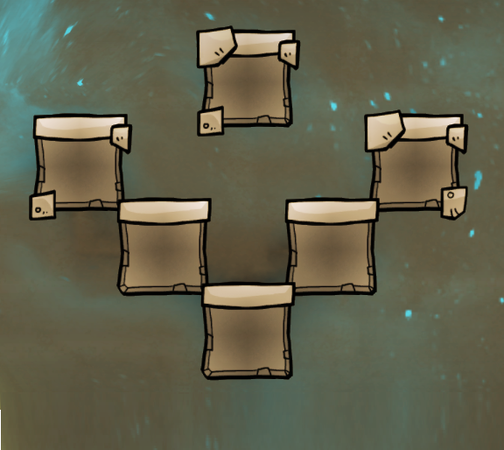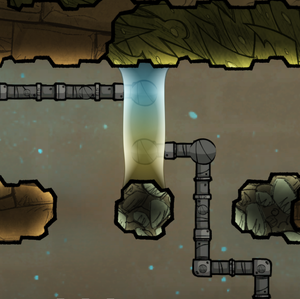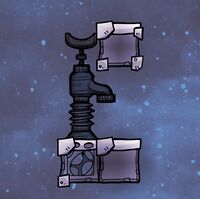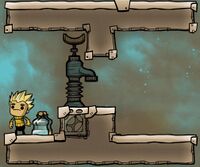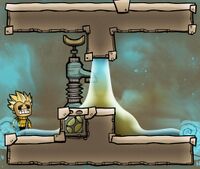Guide/Liquid Airlock
A Liquid Airlock or Liquid lock is an alternative to a regular airlock. It is a player-made design, exploiting game's handling of liquids and gasses.
Advantages
The Liquid Airlock fully stops gas flow between two rooms. Unlike the regular airlock it makes the room 100% airtight. It requires neither power nor complex automation circuits and is even able to easily contain vacuum.
Disadvantages
Walking through liquid, even pure water gives duplicants the Sopping Wet debuff. Dupes that repeatedly use the airlock also are at risk of contracting Chilly Surroundings or Toasty Surroundings due to change in body temperature.
Equipping duplicants with Atmo Suits prevents both issues.
Construction
Any liquid can be used to build an airlock, but most often it is built out of water, oil, or, at later stages, Visco-Gel.
The classic 1-Fluid "Staircase" Liquid Lock
The pictures below illustrate the bare minimum requirement for an airtight water lock. It's just four water tiles arranged into a T shape, with the minimum number of containing tiles to prevent spillage and one tile in the middle making contact with the water's surface to create the seal.
Note that Duplicants can traverse stairs as long as each stair has two tiles of vertical clearance. The middle has two tiles of water at -2 elevation, and the two steps to the left and right transition back at +0 elevation.
There are multiple ways to get water to the tiles but the Bottle Emptier is the easiest and most reliable. Make sure "Water" and "Enable Autobottling" are selected/turned on under the Bottle Emptier's options.
Requirements:
- 6 Tile
- 1 or 2 Bottle Emptiers
- At least 1,001 kg of Water
The 2-Fluid "Vertical" Liquid Lock
Dual-fluid vertical airlocks are more compact and the lack of stairs makes them faster to for duplicants to traverse, but the recipe for lock construction recipe is a bit more complicated (see the tips), and these locks are vulnerable to additional failure modes, such as accidental mopping and outgassing (see the section on reliability). As with 1-fluid locks, duplicants without an atmo-suit incur the "Sopping Wet" debuff when transiting a liquid lock.
In some cases, it's pragmatic to combine the two lock types, using a 1-fluid lock to guarantee reliable containment (especially for something like a high-pressure steam room), then using a more compact 2-fluid lock to creating the separating vacuum chamber that blocks heat transfer. An atmo-sensor + notifier can serve as an alarm for detecting containment failure, at which point you can just reestablish the lock and vacuum separation. Bleeding a bit of heat transfer for a short time period isn't a big deal, especially compared to the fun and exciting consequences that would arise from accidentally releasing 200kg of steam pressure into a base that's nominally supposed to have ~2kg of O2 pressure.
Constructing 2-fluid locks (via pipe deconstruction)
- Prepare a 3x4 Space like this ( X are any gas, and O is any Tiles) (The 2 X on bottom is important to let the liquid leave and form the lock)
XOXXXXXXXXOX
- Pipe in 2 different type of liquid (preferably water and polluted water)
- Pipe those two liquid each on top of each-other between the two tiles (Numbers is where the liquid pipe should be at) (use bridges to nowhere to make the liquid flow there):
XOXX1XX2XXOX
- Deconstruct those pipe between the tiles without emptying it
- Voila
Constructing 2-Fluid locks (via bottle-emptier)
There is an alternative way of building 2-fluid locks using a Bottle Emptier rather than piping the fluids to the construction site. However, it usually makes a bigger mess than pipe deconstruction.
Requirements:
- An empty 3x4 space
- 1 Mesh Tile
- 1 Bottle Emptier
- Bottles of desired liquid (water and polluted water will be used here)
Expect a lot of overflowing and mopping afterwards
Tips
- It's possible to consistently construct these 2-layer vertical locks on the first attempt, but the recipe is quite specific, so you must be very precise or the lock will break and you'll have to start over.
- 1) Prior to lock construction, the tiles to the left and right need to have complete drainage or lock construction will be unreliable. Don't try to construct the lock with just one tile step down on the left and right as shown in the final picture. Make sure there's at least two clear spaces below the tiles to the left and right of the bottom water blob. You can add the tiles back in once the lock is constructed. You might be able to get the same effect by mopping after inserting the first liquid, but you'd have to delete the mesh tile to do this.
- If you have the space to put a U-shaped catch basin below the lock construction area, this simplifies post-construction mopping. This can be as simple as adding two blocking tiles to the floor below so that the liquid spill doesn't spread arbitrarily far to the left and right.
- 2) Place the heavier (bottom) liquid first, as otherwise they will need to exchange places and this can be unreliable. If lock construction fails and there's a blob of the lighter liquid on the tile, just mop it up and start over.
- 3) Pause the game the instant the bottle hits the liquid dispenser, then unselect that liquid from the dispenser to stop the flow. You only need one drop of each liquid, preferably in the milligrams. More quantity doesn't help, makes post-construction clean-up messier, and can sometimes even break the lock if it causes the liquid blob to come in contact with nearby surfaces.
- Using liquid bottles derived from mopping up the minimum sized liquid pools after water spreads horizontally, it's sometimes possible to construct the lock without spilling any drops on the floor below. But it's much easier to just build a small U-shaped catch basin and mop that after construction.
- After lock construction, you can add the adjacent tiles back in. Heck, you can even add in tiles such that the floor is entirely flat (which looks really cool!), and the liquid stack won't break ... immediately, but I suspect that this might make the locks more likely to fail later on (I'm unclear why; I just come back and find them failed after reloading the game).
2-Fluid Lock Reliability Issues
The 1-fluid staircase lock is the most robust -- the only failure modes are: boiling the fluid, deconstructing one of the containing tiles, or pumping out the liquid. Even freezing the liquid isn't usually a containment failure as the resulting solid tiles will usually continue to block air exchange. If duplicant flatulence displaces the liquid in the center, gas exchange will still be blocked by the liquid on the sides, even though they will not appear to connect to the ceiling in the center.
The 2-fluid locks add several additional failure modes:
- Unintended Mopping - if you drag select mop a large area, containing a liquid lock, your Dupes will happily obliterate the liquid lock. With smaller liquid volumes, the wings of a 1-fluid lock are sometimes moppable, but even so, this doesn't always break the lock and it can be mitigated by just inserting enough liquid to prevent mopping.
- Contact with other liquid drops - If you get flooding, especially of 2+ fluids where the flood stacks 2+ tiles high, and the flood touches your liquid lock, if one of the flood liquids matches one of the lock liquids, the lock is usually broken. If it's disparate liquids, the lock usually survives unless there's so much fluid that the fluids start swapping positions. This failure mechanism can be especially problematic for locks that use Polluted Water.
- Duplicants carrying hot materials through the lock (i.e. some fresh gold from a volcano) can accidentally boil it, as liquid amounts involved are very miniscule.
- The pressure of the fluid may not be enough to prevent duplicant-carried solids or liquids from emitting gasses, which can displace the fluid in the lock. A duplicant with the Flatulent trait can also break the lock by emitting Natural Gas.
- Unknown - I've had some of my 2-layer liquid locks come back as failed after save / load cycles, and I'm not really clear why. Then again, I've got other 2-layer locks that have survived for 1000's of cycles, so it's definitely possible for this design to stay reliable. These are my superstitions: Insulated tiles in contact with the fluids might be more reliable than other tile types. Constructing pure flat 2-layer locks (ones that look like visco-gel locks, but made with water / oil / etc), while possible / not hard, might be more long-term unreliable. Locks near areas that you are mopping more often are definitely less reliable. The game has a bug where save-game pauses can cause commands to sometimes be applied to large regions (I had it try to deconstruct 99% of my base once), and it's possible that this bug issued a mega-mop command that destroyed some of my locks without me realizing it.
Fluid Choices and Temperature Ranges
- For room temperature locks, Water over Polluted Water is immediately available early-game, Polluted Water over Salt Water has a slightly wider temp range (salt water is liquid from -7 C to 99 C), Polluted Water over Brine has the lowest freezing point (-21 C), and Water over Salt Water provides the prettiest color combination and doesn't off-gas polluted oxygen during construction.
- For temperatures up to 400 degrees, Petroleum over Crude Oil is the go-to solution, and it works down to -40 as well. Beyond 400 degrees, Crude Oil spontaneously converts to Petroleum, gaining volume and usually bubbling explosively. Below -40, Crude Oil freezes.
- For temperatures beyond 400 degrees, such as in a hot steam chamber, Petroleum over liquid Naphtha (from melting Plastic) works temperatures between -40C and 539 C. Beyond that point, the only viable option is Molten Lead (liquid from 327 C to 1749 C), but there isn't an easy second liquid available for a 2-layer vertical lock until 660 C for Molten Aluminum (660 C to 2470 C) or 800 C for Molten Salt (800 C to 1465 C). At that point, containment will generally take precedence over convenience and space economy, and a more robust 1-fluid lock stair-step is generally safer.
- Between 325 C and 538 C, it's technically possible to use {Petroleum over Molten Lead}, but the narrow range of safe temperatures makes this a very dangerous combination. Below 325, the lead will freeze, and digging it out will break the lock, and above 538, Petroleum irreversible converts to vast clouds of Sour Gas, which you can't easily process until you have Thermium and Super Coolant to build a late-game Sour Gas Boiler.
- Liquid Uranium combined with Molten Lead is a valid alternative that can allow a stable liquid lock from 327 C up through 1749 C. Note, however, that liquid Uranium emits radiation, though this is often negligible in the quantities used in a 2-layer vertical liquid lock.
- With the Frosty Planet DLC, liquid Mercury is another option for moderate-temperature liquid locks. It has a freezing point (-39 C) and boiling point (357 C) similar Crude Oil, and while it has much lower specific heat and much higher thermal conductivity (making it much easier to accidentally boil or freeze), it is also available much earlier on Ceres planetoids. Mercury is more dense than all variants of water, as well as Petroleum, but less dense than Crude Oil.
- Also with the Frosty Planet DLC, Nectar is a good option for low-temperature locks. While a bit more difficult to get than liquid Mercury (it can only be harvested from fully-grown [[Bonbon trees], it has a much lower freezing point (-82.5 C) than Mercury, Crude Oil, Petroleum, or any variant of Water, and has a notably higher boiling point (160 C) than any type of Water. Nectar over Ethanol can make a stable liquid lock all the way down to -82.5 C, which also remain stable up to nearly 80 C. Alternatively, the Ethanol can be replaced with Petroleum to increase the boiling point to 160 C, at the cost of moving the freezing point up to -57 C. Nectar has the same density as Salt Water.
See Also
- Real-world discussion of using liquid-locks on the Moon, and why it would (not) work (hint: water vaporizes in a vaccum, and other fluids like Mercury pose their own challenges; also real-world airlocks work a lot better than the ones in ONI).
- There is also an advanced recipe where you create a vacuum via 3 mechanized airlock, and create two waterlock beside the central vacuum door. (This version creates virtually no heat.)

